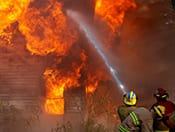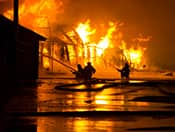Calculation of Average Clause in Fire Insurance
It is essential to understand the calculation of the average clause in fire insurance in order to determine the liability of the insurer for the reimbursement of the claim.
The average clause formula that the insurer generally uses to determine the value of an insured claim could be denoted as:
Insured claim amount= (Actual loss x Insured value) / Actual value of property
In the average clause formula mentioned above,
- Actual loss refers to the loss that has been incurred by the insured during the occurrence of fire.
- Insured value refers to the value for which the insurer purchased the fire insurance.
- The actual value of property refers to the total value of the property at the time or day of fire incidents. The actual value is determined after applying the appropriate depreciation on the insured property.
Case Study
Let us discuss a case study in order to see how the average clause in fire insurance policy is determined.
Mr. Suresh, the 45 years old businessman, owns a factory manufacturing garments, which he caters to the shopper for business purposes.
One day, during the operation of a business, a fire engulfed his factory where he lost the stocks of garments that were ready to sell. He approached the insurer of fire insurance online and claimed the loss. The surveyor found the average clause in the fire insurance policy and discovered the value of the claim as follows:
Actual value: INR 4,00,000
Sum Insured: INR 3,00,000
Loss incurred: 2,00,000 (Since half of the stock caught fire)
Hence, on the basis of the average clause in insurance policy, the surveyor determined the claim value by applying the formula mentioned above:
Insured claim amount= (Actual loss x Insured value) / Actual value of property
= (2,00,000 x 3,00,000) / 4,00,000
= 1,50,000
The insurer is liable to pay INR 1,50,000 while the insured has to bear INR 50,000
How to Avoid the Average Clause in Fire Insurance?
To avoid the Average Clause in fire insurance, the best approach is to insure your property for its full value. However, accurately assessing the property's value can be challenging due to factors like depreciation, appreciation, inflation, renovations, and market fluctuations.
Here are some tips and recommended actions to prevent common issues in fire insurance policies:
- Consult an Expert: Seek advice from a valuer, architect, or engineer to determine the accurate value of your property. These experts can also recommend the appropriate policy and coverage for your property and needs.
- Use Online Tools: Utilize calculators, estimators, or comparators to help estimate your property's value. These tools can provide a range or benchmark based on various factors such as location, size, age, condition, and features. However, be aware that they may not always be up-to-date or fully accurate for your specific property.
- Update Valuations Regularly:Regularly update your property's valuation, at least once a year, or whenever significant changes occur, such as renovations, extensions, or improvements. This helps adjust the sum insured and the premium accordingly, avoiding underinsurance or over-insurance.
- Review Policy TermsThoroughly review the terms and conditions of your fire insurance policy before purchasing or renewing it. Pay attention to exclusions, limitations, and endorsements that could affect claim settlements.
Average Value Clause vs Reinstatement Clause in Fire Insurance
The average value clause applies to policies based on the property's market value, accounting for depreciation. The reinstatement value clause applies to policies based on the replacement or repair cost of the property, unaffected by depreciation.
Conclusion
The average clause in fire insurance can be calculated by another method given below.
Value of goods: INR 1,00,000
Insured value: INR 30,000
Loss due to fire: INR 20,000
In this circumstance, INR 30,000 represents the value of goods which is 30 per cent of the total value of goods. The loss incurred due to the fire is INR 20,000 (20 per cent of the total value of the goods). Hence, the insurer will only pay 20 per cent of the insured value, INR 6,000. The remaining INR 14,000 will be borne by the insured.



























 Expert advice made easy
Expert advice made easy


